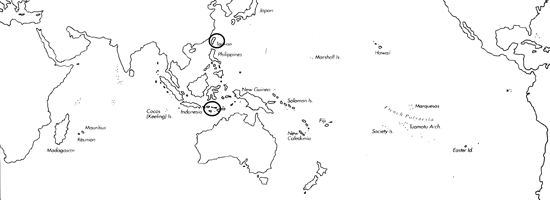Range: Taiwan and Indonesia (Sumba).
Description: Moderately small to medium-sized, usually moderately light. Last whorl ventricosely conical; outline convex, less so basally. Aperture wider basally than near shoulder. Shoulder subangulate. Spire of moderate height, outline slightly concave to slightly sigmoid. Larval shell of about 2.25 whorls, maximum diameter about 1.1 mm. Teleoconch sutural ramps almost flat, with 1-2 increasing to 3-4 spiral grooves; additional spiral striae on last 2 ramps. Last whorl with regularly or irregularly spaced punctate spiral grooves from base to shoulder.
| Shell Morphometry | ||
|---|---|---|
| L | 30-44 mm | |
| RW | 0.06-0.12 g/mm | |
| (L 29-40 mm) | ||
| RD | 0.52-0.67 | |
| PMD | 0.78-0.82 | |
| RSH | 0.15-0.18 | |
Ground colour white to greyish white. Last whorl with interlaced orange, red or brown axial flames and blotches, sometimes forming a coarse meshwork or replaced by pale spiral bands on each side of centre. Base often violet or orange. Larval whorls white. Later sutural ramps with confluent radial markings matching pattern of last whorl in colour and intensity. Aperture white or light violet deep within.
Habitat and Habits: Subtidal; reported from muddy sand bottoms.
Discussion: C. oishii is similar to C. cinereus in size and shape. The latter species differs in its colour pattern, which lacks white ground colour and reticulate pattern but has spiral rows of dark and light markingd on the last whorl. C. cinereus has a brown apex, a narrower larval shell (0.8 vs. 1.1 mm) and weaker spiral sculpture on its later sutural ramps; its early postnuclear sutural ramps bear a pronounced subsutural groove while those of C. oishii are more evenly sculptured. C. lienardii resembles C. oishii in size and pattern. It can be distinguished by its finer pattern, narrower last whorl, angulate shoulder, tuberculate early postnuclear whorls, and brown apex. Shells of C. oishii from Indonesia (Pl. 18, Figs. 31, 32) differ from those from Taiwan in their broader last whorl.

C. oishii range map
This section contains verbatim reproductions of the accounts of 316 species of Conus from the Indo-Pacific region, from Manual of the Living Conidae, by Röckel, Korn and Kohn (1995). They are reproduced with the kind permission of the present publisher, Conchbooks.
All plates and figures referred to in the text are also in Röckel, Korn & Kohn, 1995. Manual of the Living Conidae Vol. 1: Indo-Pacific Region.
The range maps have been modified so that each species account has it own map, rather than one map that showed the ranges of several species in the original work. This was necessary because each species account is on a separate page on the website and not confined to the order of accounts in the book.